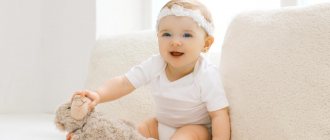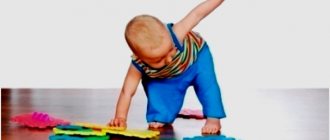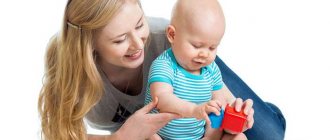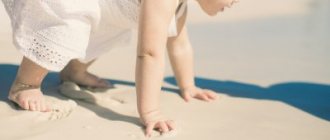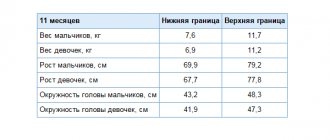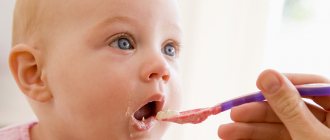Features of the age of 10 months
Standing up
Two important stages of development - lateral sitting and crawling - create the prerequisites for further rise to the legs. In an oblique seat, he can sit up high, reaches for objects above his head and examines everything around with curiosity. And the long crawling phase gives the child the trunk stability necessary for an upright position.
With normal development, lifting is achieved when the child can grab hold of objects and pull himself up. The driving force behind verticalization is again curiosity. If motivated, the child stretches and pushes upward: at first he mainly pulls himself up with his arms, later his legs also become strong enough to lift his body up and hold him.
Lifting occurs from an oblique sitting down or from a position on all fours, from which the child pulls himself up, leaning on the furniture, in a kneeling position, then raises one leg and remains in an asymmetrical position, where one knee is bent and stands on the foot, and the other still rests on land. Later he will be able to push off and climb up a smooth wall, but it will still take time to learn to maintain his balance.
It takes at least three months before taking the first step, which follows from a standing position. At first, the child gets up with his legs spread wide apart and feels unsteady. To stay on his feet, the baby needs both hands for support: if he lets go of even one, he will inevitably fall back to the floor.
Note
Do not try to put your child in a standing position on your own or prematurely! He must learn to do it himself. Only in this case will his body and muscles be prepared: his torso will be strong enough, and his legs and spine will be straight.
How to teach a baby to walk?
All natural skills are already inherent in a person by nature. From birth we know how to breathe and swallow mother’s milk, a little later we sit up in the crib and try the first purees and cereals. We also learn to walk ourselves: when the time comes and the baby’s body is ready for this, he will take his first steps.
Don't think about how to teach your baby to walk - he will learn it on his own. Parents only need to help their child a little at first, when he has not yet fully realized the benefits of walking upright. Do not force your baby to give up crawling ahead of schedule, but if you see that he is making his first timid attempts to stand on his feet, try to motivate him to continue experimenting.
- To improve coordination, place your child on a fitball with his back to you and, holding him, swing him from side to side. This exercise helps develop a sense of balance.
- Place the child on your lap and lift him up so that he straightens his legs. This exercise will help strengthen your leg muscles and prepare them for the first steps.
- Take your baby's favorite toy and move it across the floor so that your baby crawls after it. Then place the toy on the edge of a chair or sofa. If the baby is ready for this, he will use the support and stand on his legs to get the toy.
- When young children learn to walk, they need support. Let your baby grab onto you until he can balance without support.
Development of arms and legs
At this stage of development, the child can hold two objects in one hand at the same time, for example, two cubes. He learns to pull toys towards him by a string.
One of the most common activities from the age of 10 months is games with throwing objects. If the child is high enough, he will enjoy dropping toys, watching them fall, fly away and disappear from sight. And the baby will feel unconditional joy when the toy is picked up and returned to him, and he starts the exciting game again until he gets bored. However, he cannot yet consciously let go of the toy; you need to help the baby do this, for example, lightly knock it out of his hands.
At 10 months, the child often discovers the so-called pincer grip:
This additional way of grasping objects originates from the pincer grasp and allows the child to grasp small objects even more accurately. In a pliers grip, the tip of the thumb meets the tip of the index finger—nail to nail. For this grip, it must be possible to spread the thumb wide and rotate it towards the index finger. The joints of the two fingers are slightly curved and look like forceps when grasped. This form of grasping is the most complex or differentiated grasping function that a child can master in the first year of life. Even adults cannot always demonstrate a pincer grip correctly, since it requires a fully expanded thoracic spine. The more bent a person is and the more rounded the thoracic spine, the more limited the mobility of the arms.
With this method, the child can increasingly collect small pieces of bread, oatmeal or peas during meals, examine them and put them in his mouth. When exploring objects, the child now learns to use only the index finger, for example, turning the wheels of toy cars.
another skills
Vision
From this stage of development, nothing goes unnoticed by the child: he can now see clearly even at a great distance.
Hearing
The child begins to perceive noises that are outside his field of vision. If a car drives down the street, he listens carefully to the noise and may freeze for a while.
Speech
Linguistic imitation becomes more and more accurate: the child tries to repeat the first spontaneous words. Often the first word is “mom” or “dad”. The baby denotes animals using the sounds that a particular animal makes, for example, a dog at this age will be called “woof-woof.”
Social behavior
The child begins to recognize his toys, i.e. he can distinguish his own from someone else's. He laughs at his reflection, studies it and touches the mirror, but does not yet recognize or identify himself. But now he answers to his name.
Do not forget that now the baby begins to test the parents’ prohibitions: how consistent or inconsistent the adults are in their position; what really shouldn’t be done, and where mom and dad and other adults can give in. He is aware of when and who he wants to hug.
And at this stage, children often strive to imitate the actions of others, for example, drinking from a cup or eating with a spoon.
Recommendations for play and movement
With the development of standing up, the baby's feet increasingly lose their grasping skills and are used mainly as a support. Try to let your child play barefoot - this is very useful, this way he receives more impulses through the feet and the foot muscles become stronger. If you hang interesting toys on the bars of his bed or playpen, your child will want to pull himself up. Motivate your baby, but don’t “help” him by pulling him up!
Say NO to walkers
Apparently, the walkers recommended by some experts are completely unsuitable. They are designed to keep your baby upright and make him walk faster. However, such devices constrain and interfere with quality movement and development.
In front of the child there is a certain play area that encourages him to walk, but because of this the baby does not see what is under his feet. In such a device, the child is pushed forward or backward on tiptoes. Walkers are a very unsafe device because... the baby is at great risk, especially if there are stairs in the house. There are known cases of life-threatening situations when a child fell down the stairs in a walker. Remember that the baby is not yet able to hold himself, especially in conditions of limited movement.
In addition, parents too often try to use these devices on their children too early. As a result, babies do not develop natural movement patterns, do not learn to straighten up on their own, and are deprived of the crawling phase necessary for their competent development, in which the muscles and joints gradually prepare for future verticalization of the body. Most children are not yet aware of the space at the top and are not yet ready to gradually learn to stand up. The main muscles of the body in a child who has not gone through all the important phases of development in the required sequence are not yet sufficiently trained, therefore, during passive straightening (when parents “force” the child to stand up, straighten and walk), his spine is curved. The consequences can be disastrous - an arched (hyperlardosis) or hunched back. The feet are also not accustomed to such loads without sufficient preparation and, when passively straightened, can sag under the weight of the body, which leads to flat feet. Devices that are too high for a child lead to an equinus position of the foot, i.e. The child learns to walk on tiptoes. And when he is freed from the walker, he will not be able to walk normally, but will run on tiptoes, and it may take years for the child to get rid of this habit.
Eat together
During this period, molars often erupt, and the child increasingly needs solid food. If you prefer to eat together as a family, allow your child to participate in the process by having him try small portions of your food or try drinking from a real cup, etc. Spend this time enthusiastically and joyfully. Remember, you can determine what and when your baby will eat, but let your child decide for himself how much he wants and can eat.
Enjoy meals together and outside the home if you can, without being distracted by reading newspapers or watching TV. The child must also be able to touch, explore and consciously perceive his food. But set limits if he starts playing with his food, testing your patience. Keep in mind that their first experience together at the family table will give your child an idea of what food means. In this case, you become a role model for the child. Eating together is an equal parts social and sensory learning process for your baby, rather than an anxious, negative experience accompanied only by inhibitions.
Why do we need plates on teeth?
Plates for correcting malocclusion in children are orthodontic devices with plastic bases. They reproduce the shape of the palate and the inner surface of the teeth as accurately as possible. This creates the correct conditions for the positioning of incisors, canines and molars when they change from baby to permanent.
Plates on teeth are designed to perform the following functions:
- expand the dental arch;
- correct the tilt or rotation of teeth;
- provide free space for growing permanent teeth;
- prevent displacement of the dentition;
- correct the size of the sky;
- regulate the growth of bone and jaw tissue;
- model the shape of the upper and lower jaw.
To carry out these tasks, screw mechanisms are built into the plate on the teeth. Their number and location depend on the individual characteristics of the bite. Also, the orthodontist can provide separate elements that will improve the position of individual teeth (that is, straighten their rotations or inclinations). The more such mechanisms and elements in the plate, the higher its cost.
Turning the screw one step frees up ¼ mm of space in the dentition. The child does not experience pain - he feels only slight pressure, which completely disappears after a maximum of 20 minutes.
For the sake of the child’s psychological comfort, the plates are usually made bright and cute, sometimes fairy tale and cartoon characters are drawn on them. Let the child think that this is a toy or decoration, and not a medical item - this way he will be more willing to wear it.
ATTENTION:
Such devices are most often prescribed to children under 12 years of age. However, adults also sometimes wear plates - usually non-removable.
